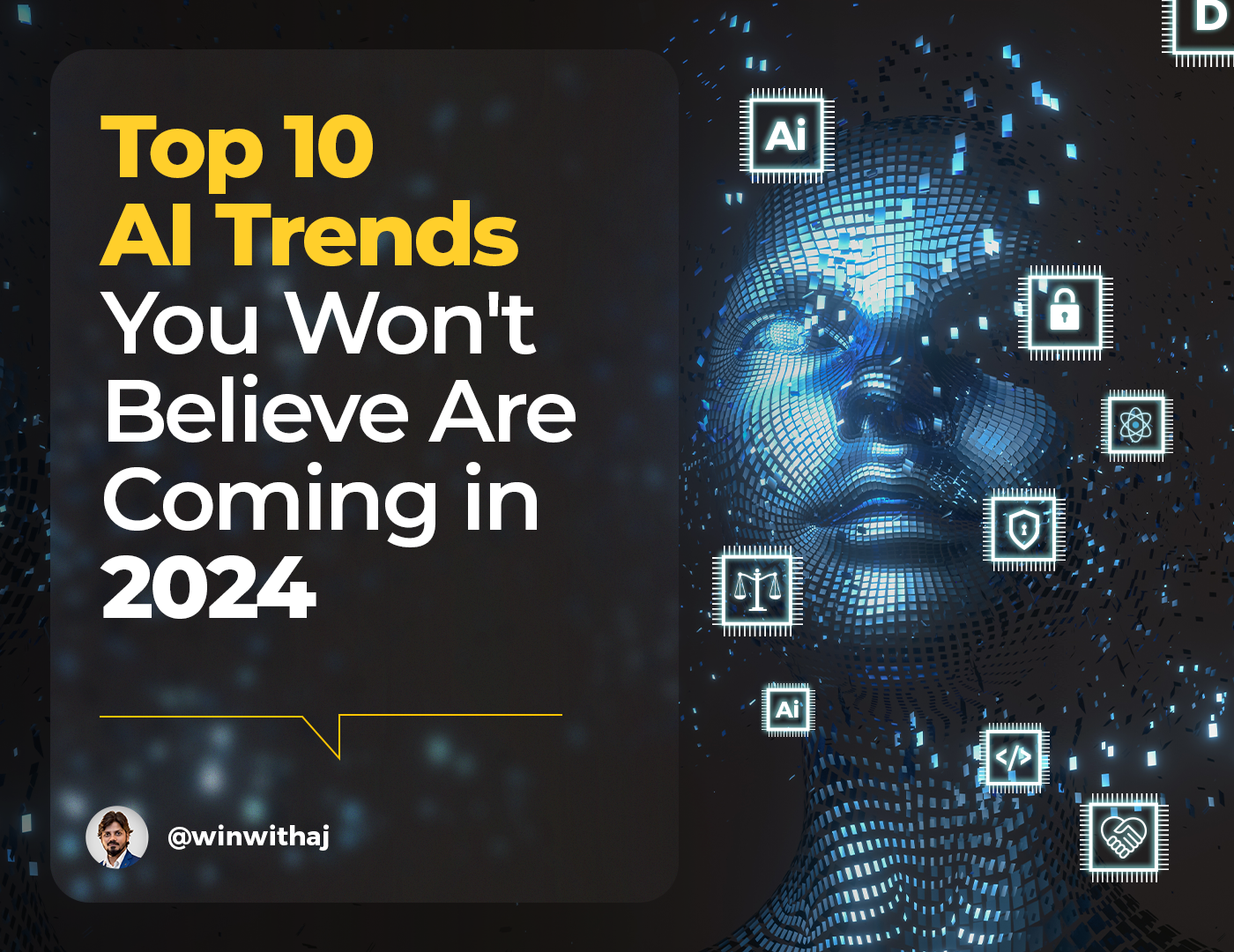
Top 10 AI Trends You Won’t Believe Are Coming in 2024
Are you ready to dive into the future and witness the revolution or AI Trends that AI software is bringing to our world? Believe it or not, this transformative technology is already changing the way we live, work, and interact with technology. With the global AI market expected to hit a whopping $190.61 billion by 2025, it’s clear that this is just the beginning.
To help you stay ahead of the curve, our comprehensive guide is here to introduce you to the top 10 AI trends that will reshape our world. Get ready to unlock the unfolding landscape of artificial intelligence and gain the insights you need to thrive in this exciting new era.
1. Generative AI: The Creative Powerhouse
Generative AI (GenAI) is emerging as the disruptor of the decade, wielding the ability to generate creative content across various domains. From text and code to musical compositions and visual art, GenAI is a game-changer. Trained on massive datasets, these models learn patterns and use them to create new outputs, significantly speeding up processes.
While it won’t replace human writers and designers, GenAI offers unprecedented efficiency by automating tasks, enhancing productivity, cutting costs, and opening new growth opportunities.
Experts predict that by 2026, over 80% of enterprises will incorporate generative AI, transforming the way we work and create.
2. Augmented Working, BYOAI & Shadow AI
Enter the era of BYOAI – Bring Your Own Artificial Intelligence. With affordable and user-friendly AI tools flooding the market, employees are empowered to bring their own AI solutions to work, boosting productivity, innovation, and job satisfaction. However, this trend comes with a caveat – the rise of Shadow AI, where AI tools are used within organizations without IT oversight, posing risks like data breaches and compliance violations.
Navigating this new terrain requires a delicate balance between encouraging innovation and maintaining control over AI applications within the workplace.
3. Open Source AI: The Transparent Revolution
The surge in generative AI in 2023 was primarily fueled by proprietary models, but 2024 marks a shift towards open-source AI models like GPT-J. Offering transparency, flexibility, and cost-effectiveness, open-source solutions are gaining ground. While proprietary models won’t fade away, a forecasted 85% of enterprises are expected to incorporate open-source AI models into their tech stacks.
This shift emphasizes the need for collaboration and transparency in the AI community, paving the way for more accessible and customizable AI solutions.
4. AI Risk Hallucination Policy: Ensuring Accountability
As generative AI becomes pervasive, concerns about false outputs, known as hallucinations, are on the rise. The demand for AI risk hallucination insurance is nascent but growing. By 2024, major insurers are predicted to offer specific policies addressing the risks associated with AI hallucinations.
As the industry grapples with these challenges, ensuring accountability and mitigating risks will be paramount.
5. AI Coding: The Developer’s Sidekick
Fast forward to 2028, and three out of four enterprise software engineers will be relying on AI helpers to write code, according to Gartner. The benefits are manifold – from automating repetitive tasks to optimizing creative processes and improving code quality. AI coding tools are set to become a standard practice, with early adopters gaining a competitive edge in productivity and time-to-market.
Welcome the future of coding – where AI becomes an indispensable ally for developers.
6. AI TRiSM: Navigating the Trust-Risk-Security Landscape
AI TRiSM, or Artificial Intelligence Trust, Risk, and Security Management, is a framework designed to address the evolving challenges of developing and deploying AI models. Covering areas like explainability, model lifecycle management, data anomaly detection, adversarial attack resistance, and data protection, AI TRiSM ensures responsible AI usage.
By 2026, companies adopting AI TRiSM are projected to make better decisions by eliminating 80% of inaccurate or fake data and enhancing the reliability and ethical standards of AI applications.
7. Intelligent Apps & AI for Personalization: Tailoring Experiences
In a world increasingly dominated by personalization, AI is set to play a pivotal role. According to Gartner, by 2026, a third of all new apps will utilize AI to create personalized and adaptive user interfaces. Leveraging algorithms to analyze user data, intelligent apps will tailor content, recommendations, and user experiences, significantly impacting engagement and conversion rates.
For businesses, the key to success lies in understanding and implementing AI-driven personalization strategies.
8. Quantum AI: Where Quantum Computing Meets AI
The marriage of quantum computing and AI, known as Quantum AI, is opening new frontiers. Predicted to reach a market value of USD 1.8 billion by 2030, Quantum AI is set to revolutionize financial modeling, drug discovery, and potentially contribute to achieving Artificial General Intelligence (AGI).
This synergy between quantum computing’s computational power and AI’s optimization capabilities holds promise for breakthroughs in complex problem-solving across various domains.
9. AI Legislation: Shaping Responsible AI Practices
As AI integrates deeper into our lives, the need for legislation becomes paramount. The European Union leads the way with the proposed Artificial Intelligence Act, expected to be adopted in early 2024. This global framework aims to govern AI development responsibly. The AI Safety Summit 2023 marked a milestone, bringing experts together to discuss the risks associated with advanced AI technologies.
In a world where ethical considerations are crucial, legislation acts as a compass for responsible AI development and deployment.
10. Ethical AI: Navigating the Moral Compass
The rise of Ethical AI signifies a collective awareness of the ethical implications surrounding AI. Addressing biases, ensuring transparency, safeguarding privacy, and prioritizing safety are vital tenets of Ethical AI. With guidelines released by the European Union in 2019 and an Executive Order in the U.S. in 2023, there’s a growing recognition of the need for ethical considerations in AI.
In the coming years, businesses and developers alike must prioritize ethical AI practices to build trust and ensure responsible AI usage.
The landscape of artificial intelligence in 2024 is dynamic, promising, and brimming with potential. From the creative prowess of Generative AI to the ethical considerations embedded in AI legislation and Ethical AI, businesses and individuals must navigate this evolving terrain with a blend of innovation, responsibility, and ethical consciousness.
As we usher in the new era of AI, those who adopt these trends will find themselves at the forefront of a transformative wave, shaping industries and redefining the future. Welcome the possibilities, stay informed, and let the power of AI propel you into a future where innovation knows no bounds.
Still unsure how to navigate the AI Trend? Schedule a Free Discovery Call with Ajay Prakash today! Let’s explore how these AI trends can reshape your business, boost productivity, and set you on the path to success.



















